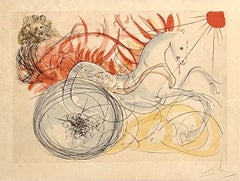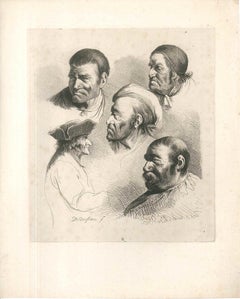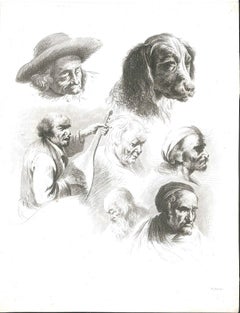Jean-Jacques de Boissieu Animal Prints
Jean-Jacques de Boissieu was a French artist who studied at the École de Dessin in Lyon, but he was mostly self-taught. His first prints were realized between 1758–64. When he went to Italy in the retinue of the ambassador Louis Alexandre and Duc de la Rochefoucauld d’Enville, he had a life changing encounter when he met Voltaire and entered the world of luminaries. He had the opportunity of realizing some plates for the Diderot-d’Alembert’s Encyclopèdie. Then he continued to produce prints in Lyon. Boissieu made many etchings of the Roman and Dutch countryside as well as the French countryside around Lyon, which earned him a reputation as the last representative of the older etching tradition.
Late 18th Century Old Masters Jean-Jacques de Boissieu Animal Prints
Etching, Drypoint
Late 18th Century Old Masters Jean-Jacques de Boissieu Animal Prints
Etching, Drypoint
1790s Old Masters Jean-Jacques de Boissieu Animal Prints
Engraving, Paper, Etching, Aquatint
1970s Surrealist Jean-Jacques de Boissieu Animal Prints
Drypoint, Etching, Lithograph
Late 19th Century Old Masters Jean-Jacques de Boissieu Animal Prints
Etching
1970s Surrealist Jean-Jacques de Boissieu Animal Prints
Drypoint, Aquatint
1970s Surrealist Jean-Jacques de Boissieu Animal Prints
Drypoint, Aquatint
1910s Modern Jean-Jacques de Boissieu Animal Prints
Drypoint, Etching
1910s Modern Jean-Jacques de Boissieu Animal Prints
Drypoint, Etching
Late 18th Century Naturalistic Jean-Jacques de Boissieu Animal Prints
Paper, Ink, Engraving
Late 19th Century Old Masters Jean-Jacques de Boissieu Animal Prints
Etching
1970s Surrealist Jean-Jacques de Boissieu Animal Prints
Drypoint, Aquatint
1970s Surrealist Jean-Jacques de Boissieu Animal Prints
Drypoint, Aquatint
Early 19th Century Realist Jean-Jacques de Boissieu Animal Prints
Drypoint, Etching, Laid Paper
Late 18th Century Old Masters Jean-Jacques de Boissieu Animal Prints
Drypoint, Etching
Late 18th Century Old Masters Jean-Jacques de Boissieu Animal Prints
Drypoint, Etching





